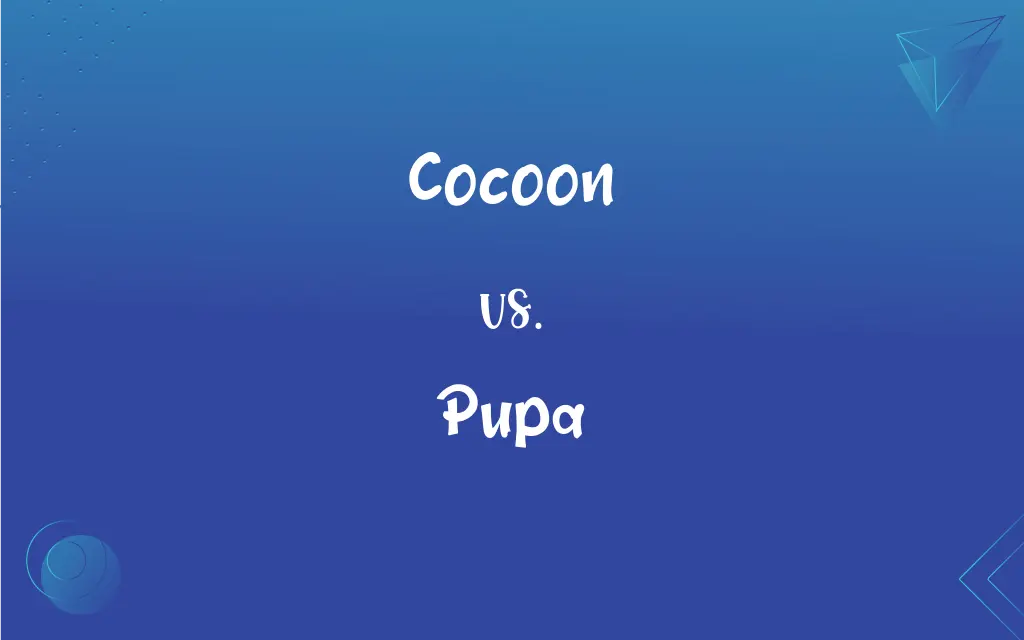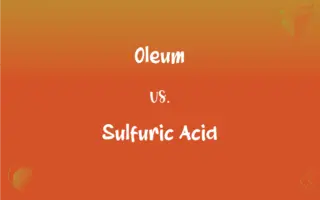Cocoon vs. Pupa: What's the Difference?
Edited by Aimie Carlson || By Harlon Moss || Published on January 13, 2024
A cocoon is a protective casing spun by some insects, while a pupa is the developmental stage of insects within this casing or exposed.

Key Differences
A cocoon is a protective covering made by certain insects during their pupal stage. Pupa, on the other hand, refers to the life stage of some insects undergoing transformation. While a cocoon is a structure, a pupa is the insect itself in a non-feeding developmental stage.
Cocoons are primarily associated with moths and other insects, serving as a protective layer during metamorphosis. Pupae, however, are the actual insects in the process of transformation, which may or may not be inside a cocoon, depending on the species.
The material and structure of cocoons vary among species; some are silk-based, others may use different materials. In contrast, the pupa is uniform in concept but varies in appearance among species, representing a crucial stage between larva and adult.
Cocoons are notable for their use in silk production, particularly from silkworms. Pupae do not directly contribute to such products but are the crucial developmental stage within the cocoons for species like silkworms.
Environmental interaction differs: cocoons protect against external threats and conditions, while pupae are relatively defenseless, relying on their cocoon or other protective mechanisms for survival during their development.
ADVERTISEMENT
Comparison Chart
Definition
Protective case spun by insects
Developmental stage of an insect
Purpose
Provides safety during metamorphosis
Stage of transformation
Association
With the protective structure
With the insect in developmental stage
Variability
Material and structure vary among species
Consistent in concept, varies in appearance
Direct Contribution
Used in silk production (e.g., silkworms)
Integral to the insect's life cycle
ADVERTISEMENT
Cocoon and Pupa Definitions
Cocoon
Protective case made by insects.
The silk from the cocoon was used to make fabric.
Pupa
Transitional phase in insect life cycle.
The pupa transformed into a beautiful butterfly.
Cocoon
Enclosure for protection during metamorphosis.
The caterpillar spun a cocoon before becoming a butterfly.
Pupa
Non-active stage in insect metamorphosis.
The pupa was safely enclosed in the cocoon.
Cocoon
Shelter spun by larvae.
The garden was full of cocoons in spring.
Pupa
Stage between larva and adult in insects.
The pupa remained motionless in its chrysalis.
Cocoon
Silk structure by certain insects.
The cocoon glistened in the morning sun.
Pupa
Insect in its non-feeding developmental stage.
The pupa stage is critical for a butterfly's development.
Cocoon
Protective covering for transformation.
Observing the cocoon, we waited for the moth to emerge.
Pupa
Developmental phase for metamorphosis.
Inside the pupa, drastic changes occurred.
Cocoon
A protective case of silk or similar fibrous material spun by the larvae of moths and certain other insects as a cover for the pupa.
Pupa
An insect in the nonfeeding stage between the larva and adult, during which it typically undergoes complete transformation within a protective cocoon or hardened case. Only insects that undergo complete metamorphosis have pupal stages.
Cocoon
A similar natural protective covering or structure, such as the egg case of a spider.
Pupa
An insect in the development stage between larva and adult.
Pupa
Any insect in that stage of its metamorphosis which usually immediately precedes the adult, or imago, stage.
Pupa
A genus of air-breathing land snails having an elongated spiral shell.
Pupa
An insect in the inactive stage of development (when it is not feeding) intermediate between larva and adult
FAQs
Do all insects form cocoons?
No, not all insects form cocoons; it's specific to certain species like moths and butterflies.
What is a cocoon?
A cocoon is a protective case made by some insects during metamorphosis.
Can a pupa exist without a cocoon?
Yes, some insects have pupal stages without cocoons, like butterflies in chrysalises.
What is a pupa?
A pupa is the developmental stage of an insect undergoing transformation.
Do cocoons vary in appearance?
Yes, cocoons can vary greatly in material, size, and structure.
Are cocoons used for anything besides protection?
Yes, some cocoons, like those of silkworms, are harvested for silk.
Are cocoons always made of silk?
No, while many are silk-based, some insects use other materials.
Is the pupa stage the last before adulthood?
Yes, insects emerge from the pupa stage as adults.
Can a damaged cocoon affect the pupa?
Yes, damage to the cocoon can harm the pupa or hinder development.
Can you see the insect inside the cocoon?
Generally, no; the cocoon usually obscures the pupa inside.
How long does an insect remain in a pupa?
The duration varies by species but can range from a few weeks to months.
Is the pupa stage active or dormant?
The pupa stage is typically a dormant phase for internal development.
Is a pupa the same as a cocoon?
No, a pupa is the insect itself, while a cocoon is the protective covering it may create.
Do all butterflies form cocoons?
No, butterflies typically form chrysalises, not cocoons.
Are cocoons found in all environments?
Cocoons are more common in environments where such insects thrive.
Can the pupa stage be skipped?
In most insects with this stage, it is essential and cannot be skipped.
Do pupae eat?
No, pupae are generally non-feeding stages.
How do insects make cocoons?
Insects like silkworms spin silk to create cocoons.
Is the pupa stage vulnerable to predators?
Yes, despite protections like cocoons, pupae can be vulnerable to predation.
Do all moths create cocoons?
Most moths do, but there are variations among species.
About Author
Written by
Harlon MossHarlon is a seasoned quality moderator and accomplished content writer for Difference Wiki. An alumnus of the prestigious University of California, he earned his degree in Computer Science. Leveraging his academic background, Harlon brings a meticulous and informed perspective to his work, ensuring content accuracy and excellence.
Edited by
Aimie CarlsonAimie Carlson, holding a master's degree in English literature, is a fervent English language enthusiast. She lends her writing talents to Difference Wiki, a prominent website that specializes in comparisons, offering readers insightful analyses that both captivate and inform.







































































